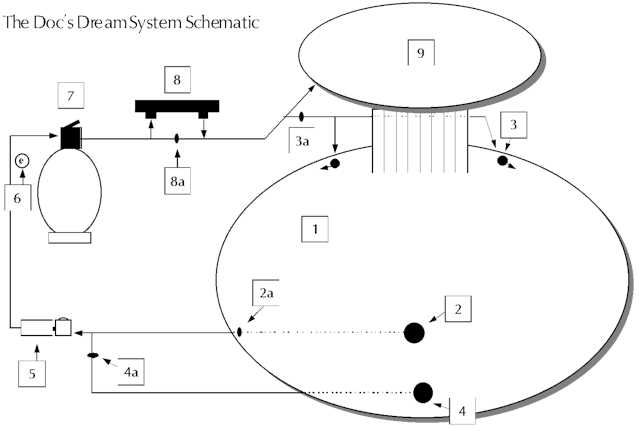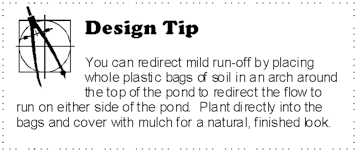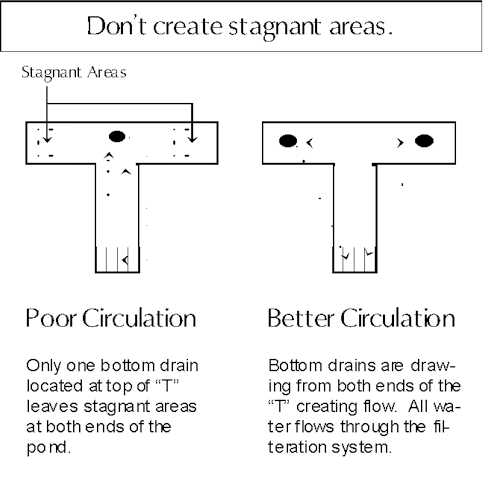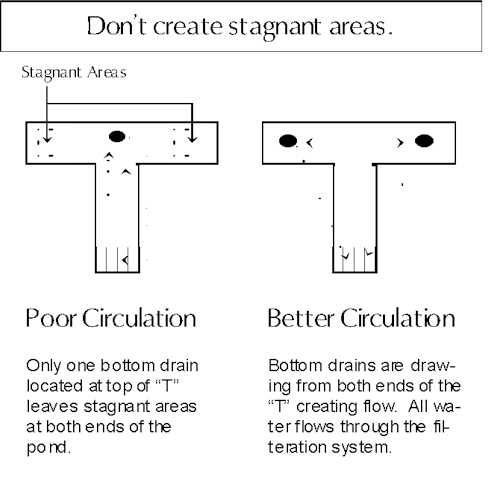Traditionally during pond season one must spend an hour or so every weekend maintaining the pond otherwise the pump gets clogged and the waterfall stops running. Anyone who “never has to clean his pond” is probably the proud owner of a swamp. Submersible pumps are often set in heavy containers filled with rocks or other filter media making it difficult to pull up out of the water. Gravity-fed biofilters, even the expensive ones, require routine cleaning regimens. If they are not cleaned regularly the pads tend to clog as well.
We’ve seen a trend with those who have had a pond for more than a couple of years. They are wanting their “weekend life” back (imagine that!) and, instead of destroying their beautiful, relaxing ponds, they are opting for another, more maintenance-free solution.
As Maintenance-Free as it Gets!
There are no truly maintenance-free pond systems. There is, however, a system that is the closest to maintenance-free as you can get! We have so many fish and display ponds at the store that if we relied on traditional gravity-fed filter systems it would take an army of employees to maintain them all. Out of necessity we were forced to develop the best system for our needs and, in the process, the most maintenance-free system for the backyard pond enthusiast.
Some folks in the water garden industry, especially those who have been around a while, have a history of downplaying or totally rejecting the effectiveness of this kind of system. As informed consumers one must take into consideration why a company might reject a new idea. Perhaps they do not understand the system. Perhaps their “tried and true” ponds from the past are all they know. This type of system has been running wonderfully for us for over 3 years. It is truly state-of-the-art and the closest to maintenance-free as one can get.
If your weekends are filled with pond “to-dos” and you’d rather spend that precious time relaxing and enjoying it - try adding a few (if not all) components of The Doc’s Dream System. It is not a filter or a type of pump. It is a combination of equipment that, when installed correctly, will offer as close to maintenance-free as you can get. It’s a component system very similar in theory to an entertainment component system. If you want DVD capabilities you add it to the system. If you don’t, the system will run without it. In “pond lingo”, if you always want clear water you add the Ultraviolet Water Clarifier. If not, the pond will run without it - just subject to algae bloom.
Regardless of whether you are adding components to an established system or in the planning stages of building a new pond you will find this edition of What’s Up, Doc? to be a valuable instruction guide. From digging the hole to landscaping around the pond you can benefit from our experience. We’ve even included money-saving and design tips to help you not make the mistakes first-time pond builders (and experienced pond professionals) make.
If a landscape company is building your pond make sure they give you the options of these components. If, by reading this article, you find that you’re more educated with this type of system than your landscaper - you may want to refer him to us so we can educate him on the proper installation or rethink your choice of contractor.
See our related article entitled "Choose Your Pond Builder Wisely"
Keep the prospective that YOU are the one who will maintain your pond. Make it easy on yourself by installing state-of-the-art products that do the job they’re designed to do. And - by constructing the pond correctly the first time you’ll save money in the long term.
Components of The Doc’s Dream System
Component 1 - Liner
You just can’t do without the “skin” of the pond.
Component 2 - Bottom Drain
This adds the option of an outside pump and runs a cleaner system by sucking up muck and debris from the bottom of the pond.
2a - Either Check Valve or Gate Valve
Which valve you place between the bottom drain and the pump depends on whether the pump is higher or lower than water level
Component 3 - Eduction Jets
These are like jets in a jacuzzi bath. They create underwater currents and push water to prevent areas of stagnation.
3a - Gate Valve
This is installed to control the amount of water that flows through the induction jets.
Component 4 - Skimmer
This fish-safe bucket allows the system to automatically rake fallen leaves and debris off the surface of the water.
4a - Gate Valve
This allows you to turn off the skimmer when you feed the fish so the food won’t go down before the fish can eat. It is also used to control the amount of suction through the skimmer.
Component 5 - Pump
You’ve got a swamp if you don’t have a pump. The outside pump comes in 2-speed models that can save money on the electric bill.
Component 6 - Power Switch
This is installed close to the bead filter for convenience of turning off the pump before changing the valve on the filter.
Component 7 - Bead Filter
A bead filter traps sand and debris while housing the good bacteria you need for a healthy pond. Never clean or replace those nasty filter pads again. A simple turn of the valve backwashes this filter and you don’t even get your hands wet.
Component 8 - Ultraviolet Water Clarifier
Say goodbye to green water forever. “UV” is the answer to get rid of algae bloom.
8a - Gate Valve / By-Pass
Maximize your UV’s potential by installing a by-pass system with a gate valve to control the flow of water through the unit.
Component 9 - Water Return
This is where your imagination can go wild! Whether it’s a gentle stream or white water rapids, create some splash and enjoy the show.

First A Little Planning…

Where Do I Place the Pond?
Don’t place it in the sun simply because some book says to put it there. There’s ups and downs to both sun and shade. Make an informed decision.
The Sun
Sunshine is good if you want water lilies to bloom. They take at least 5 hours of sun a day. Keep in mind that algae requires sun as well and it may become a bit uncomfortable for you when you enjoy the fish.
The Shade
Most plants don’t bloom very well in shade but shade feels great on hot, summer evenings. Leaves can become a problem in Fall unless you install a skimmer or netting over the pond. Herons can’t see your fish as well under a canopy of trees.
Run-Off Areas
Avoid placing the pond in areas where water runs off after a heavy rain. Watch the area you are considering when it rains to see if it is in the middle of a temporary “rain river”. Mild runoff can be redirected but if the runoff is too heavy you may want to rule that location out. Runoff can get between the pond wall and the liner and cause your liner to float up. You also run the risk of runoff that contains traces of your neighbors weed killer getting into the pond and killing your fish.
The bottom line is to place the pond where you’ll get the most enjoyment from it.

How Low Do I Go?
At least part of the pond should be 3 feet deep or more although that’s not what you want to hear when you’re shoveling hard dirt out by hand. Fish need 3 feet for protection from predators. Waterlilies do their best in 3 to 5 feet of water. The deepest end of the pond is where you place the bottom drain and that should be located furthest away from the water return. We presently know of no local ordinances that directly deal with the depth of ponds. It is our understanding from placing calls that an ornamental fish pond is not addressed. A privacy fence must be installed around pools or bodies of water over 18” deep if it is to be used for human recreation. As far as we know there have been no problems with local ordinances though it is advisable to run it through your homeowners’ association before digging. Oh, and a suggestion: rent a backhoe. It’s easier on the back.
Is Bigger Better?
Yes. The more water the pond holds the more plants and fish it will support and the less effort you’ll need to keep it looking good. Ask anyone who has a pond if they would make it bigger if they had to do it over again and most will say yes.
What Style Should it Be?
The question really should be “Do I want a formal or natural pond?”. Formal ponds are usually squares, rectangles, exact circles...well, you get the picture. Natural ponds follow the ground’s natural lines and have no definite shape. The shape and style is strictly up to you, however, any shape that you choose should be designed so that it allows for good water circulation. For example, a rectangular shape is good when your bottom drain is located at one end and your water return is at the other. A T-shape is definitely NOT a good idea unless you plan for two bottom drains and induction jets to circulate the stagnant areas as shown below.
The best water flow is from rounded edges, not corners. The bottom drain should be as far away from the water return as possible to insure maximum circulation. When planning the shape of the pond the most important issue is that the water circulates properly. If the pond is built with corners the best circulation is achieved with the addition of induction jets to push the water around the corners and proper placement of the bottom drain.
